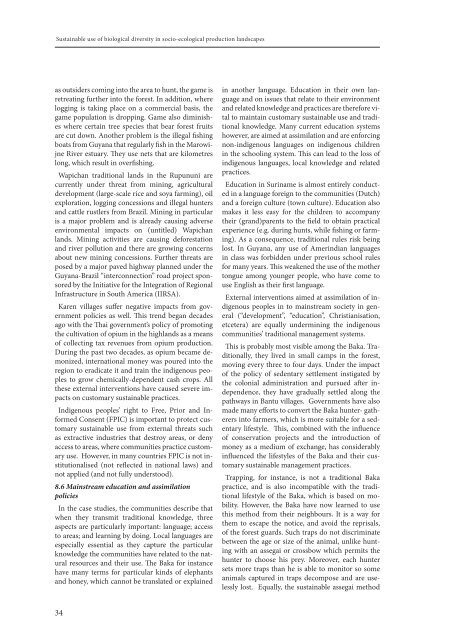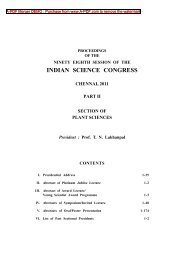sustainable use of biological diversity.pdf - India Environment Portal
sustainable use of biological diversity.pdf - India Environment Portal
sustainable use of biological diversity.pdf - India Environment Portal
Create successful ePaper yourself
Turn your PDF publications into a flip-book with our unique Google optimized e-Paper software.
Sustainable <strong>use</strong> <strong>of</strong> <strong>biological</strong> <strong>diversity</strong> in socio-ecological production landscapes<br />
as outsiders coming into the area to hunt, the game is<br />
retreating further into the forest. In addition, where<br />
logging is taking place on a commercial basis, the<br />
game population is dropping. Game also diminishes<br />
where certain tree species that bear forest fruits<br />
are cut down. Another problem is the illegal fishing<br />
boats from Guyana that regularly fish in the Marowijne<br />
River estuary. They <strong>use</strong> nets that are kilometres<br />
long, which result in overfishing.<br />
Wapichan traditional lands in the Rupununi are<br />
currently under threat from mining, agricultural<br />
development (large-scale rice and soya farming), oil<br />
exploration, logging concessions and illegal hunters<br />
and cattle rustlers from Brazil. Mining in particular<br />
is a major problem and is already causing adverse<br />
environmental impacts on (untitled) Wapichan<br />
lands. Mining activities are causing deforestation<br />
and river pollution and there are growing concerns<br />
about new mining concessions. Further threats are<br />
posed by a major paved highway planned under the<br />
Guyana-Brazil “interconnection” road project sponsored<br />
by the Initiative for the Integration <strong>of</strong> Regional<br />
Infrastructure in South America (IIRSA).<br />
Karen villages suffer negative impacts from government<br />
policies as well. This trend began decades<br />
ago with the Thai government’s policy <strong>of</strong> promoting<br />
the cultivation <strong>of</strong> opium in the highlands as a means<br />
<strong>of</strong> collecting tax revenues from opium production.<br />
During the past two decades, as opium became demonized,<br />
international money was poured into the<br />
region to eradicate it and train the indigenous peoples<br />
to grow chemically-dependent cash crops. All<br />
these external interventions have ca<strong>use</strong>d severe impacts<br />
on customary <strong>sustainable</strong> practices.<br />
Indigenous peoples’ right to Free, Prior and Informed<br />
Consent (FPIC) is important to protect customary<br />
<strong>sustainable</strong> <strong>use</strong> from external threats such<br />
as extractive industries that destroy areas, or deny<br />
access to areas, where communities practice customary<br />
<strong>use</strong>. However, in many countries FPIC is not institutionalised<br />
(not reflected in national laws) and<br />
not applied (and not fully understood).<br />
8.6 Mainstream education and assimilation<br />
policies<br />
In the case studies, the communities describe that<br />
when they transmit traditional knowledge, three<br />
aspects are particularly important: language; access<br />
to areas; and learning by doing. Local languages are<br />
especially essential as they capture the particular<br />
knowledge the communities have related to the natural<br />
resources and their <strong>use</strong>. The Baka for instance<br />
have many terms for particular kinds <strong>of</strong> elephants<br />
and honey, which cannot be translated or explained<br />
in another language. Education in their own language<br />
and on issues that relate to their environment<br />
and related knowledge and practices are therefore vital<br />
to maintain customary <strong>sustainable</strong> <strong>use</strong> and traditional<br />
knowledge. Many current education systems<br />
however, are aimed at assimilation and are enforcing<br />
non-indigenous languages on indigenous children<br />
in the schooling system. This can lead to the loss <strong>of</strong><br />
indigenous languages, local knowledge and related<br />
practices.<br />
Education in Suriname is almost entirely conducted<br />
in a language foreign to the communities (Dutch)<br />
and a foreign culture (town culture). Education also<br />
makes it less easy for the children to accompany<br />
their (grand)parents to the field to obtain practical<br />
experience (e.g. during hunts, while fishing or farming).<br />
As a consequence, traditional rules risk being<br />
lost. In Guyana, any <strong>use</strong> <strong>of</strong> Amerindian languages<br />
in class was forbidden under previous school rules<br />
for many years. This weakened the <strong>use</strong> <strong>of</strong> the mother<br />
tongue among younger people, who have come to<br />
<strong>use</strong> English as their first language.<br />
External interventions aimed at assimilation <strong>of</strong> indigenous<br />
peoples in to mainstream society in general<br />
(“development”, “education”, Christianisation,<br />
etcetera) are equally undermining the indigenous<br />
communities’ traditional management systems.<br />
This is probably most visible among the Baka. Traditionally,<br />
they lived in small camps in the forest,<br />
moving every three to four days. Under the impact<br />
<strong>of</strong> the policy <strong>of</strong> sedentary settlement instigated by<br />
the colonial administration and pursued after independence,<br />
they have gradually settled along the<br />
pathways in Bantu villages. Governments have also<br />
made many efforts to convert the Baka hunter- gatherers<br />
into farmers, which is more suitable for a sedentary<br />
lifestyle. This, combined with the influence<br />
<strong>of</strong> conservation projects and the introduction <strong>of</strong><br />
money as a medium <strong>of</strong> exchange, has considerably<br />
influenced the lifestyles <strong>of</strong> the Baka and their customary<br />
<strong>sustainable</strong> management practices.<br />
Trapping, for instance, is not a traditional Baka<br />
practice, and is also incompatible with the traditional<br />
lifestyle <strong>of</strong> the Baka, which is based on mobility.<br />
However, the Baka have now learned to <strong>use</strong><br />
this method from their neighbours. It is a way for<br />
them to escape the notice, and avoid the reprisals,<br />
<strong>of</strong> the forest guards. Such traps do not discriminate<br />
between the age or size <strong>of</strong> the animal, unlike hunting<br />
with an assegai or crossbow which permits the<br />
hunter to choose his prey. Moreover, each hunter<br />
sets more traps than he is able to monitor so some<br />
animals captured in traps decompose and are <strong>use</strong>lessly<br />
lost. Equally, the <strong>sustainable</strong> assegai method<br />
34
















